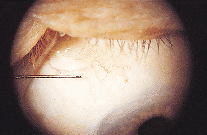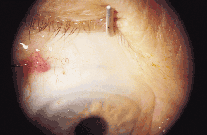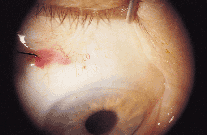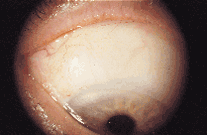Bleb needling helps improve filtration surgery outcomes
Several studies have shown benefits, though complications may occur.
Reasons for a filtration surgery failure usually are due to internal blockage of the ostium, encapsulation of the bleb and subconjunctival or episcleral fibrosis. Internal blockage of the ostium is usually seen early in the postoperative period, and gonioscopy will reveal the cause. However, whenever intraocular pressure (IOP) rises dramatically, gonioscopy should be performed.
Encapsulation of the bleb clinically is seen as an elevated or dome-shaped bleb associated with an IOP rise. It occurs in the first few weeks after surgery in about one in six cases. Many risk factors have been elucidated in previous studies but two prominent ones are male gender, which was seen in the Advanced Glaucoma Intervention Study, and previous argon laser trabeculoplasty, which has been seen in multiple previous studies.
Episcleral or subconjunctival fibrosis is the largest single cause of filtration failure and may occur at the level of the scleral flap or the subconjunctival space.
Indications cited
Indications for bleb needling include episcleral fibrosis, subconjunctival fibrosis and encapsulation. Contraindications include highly vascularized or scarred blebs, as well as active uveitis.
If a bleb is encapsulated, multiple previous studies have shown that medical therapy generally is successful in lowering the IOP, although the long-term effect on bleb function is not known. However, if IOP is not lowered to a safe level in a patient, needling may be tried and is successful in up to 94% of cases.
Studies on needling for failed filtering blebs have shown overall success rates of up to 76% without medications and up to 92% with medications. Factors associated with successful bleb needling include a longer time period since the bleb surgery, a lower pre-needling IOP, fewer previous incisional surgeries, use of mitomycin at the previous trabeculectomy and an IOP in the single digits immediately after needling.
Minor or self-limited complications after bleb needling have included bleb leak, corneal epithelial toxicity, a shallow anterior chamber, choroidal effusions, hyphema and hypotony.
More severe complications have included a bleb leak requiring suturing or glue, iris incarceration and sclerostomy, choroidal effusions requiring drainage, choroidal hemorrhage, endophthalmitis and worsened vision.
Technique defined
Use of mitomycin with bleb needling is associated with lower IOP, at least in the one series that has been reported. However, that study reported more complications. It would seem that there would be less ability to titrate the antifibrotic response. Therefore, it seems reasonable to perform at least the first needling without mitomycin.
After obtaining informed consent from the patient, I prepare the eye for needling using an antibiotic drop of topical proparacaine 0.1% on a pledget for 60 seconds, a drop of phenylephrine 2.5% to blanch the conjunctival vessels and a povidone-iodine prep of the eyelids. I keep the patient’s lids open with a speculum.
For the actual needling, I prefer a 30-gauge needle mounted on a 1-cc syringe. I bend the needle into a bent bayonet shape, although others use larger needles and bend them at just a 45° angle with the cap. At the slit lamp, the patient is asked to look down and away from the needle, and the entry site is made 5 mm to 8 mm from the filtering bleb, avoiding vessels if possible.
I guide the needle to the flap site, and the tip and the edge are used to cut the episcleral and subconjunctival fibrosis. Entry into the anterior chamber is possible, if necessary, underneath the scleral flap.
After completion of the needling, I apply a hand-held cautery close to the entry site to promote the healing of the entry site. After an antibiotic and a steroid drop, I generally give a 5-FU injection in an uninvolved quadrant.
I check the pressure immediately after the needling to check for an IOP in the single digits. If it is much lower than what we started with, I advise a patient to avoid bending over or straining because suprachoroidal hemorrhage has been reported. Patients receive a topical steroid at least four times per day. I follow up with them within 1 week and then as needed.
There have been no studies comparing the use of bleb needling with reinstitution of medical therapy in failing filtering blebs.
It is worthwhile discussing the options with the patient. I believe that if the bleb is needled, it may perform better in the long term compared with adding medications.
|
|
|
| |
|
For Your Information:
- Philip P. Chen, MD, is an assistant professor in the Department at Ophthalmology, Box 356485, University of Washington, Seattle, WA 98195-6485; (206) 543-7687; fax: (206) 543-4414. Dr. Chen has no direct financial interest in any of the products mentioned in this article, nor is he a paid consultant for any companies mentioned.




